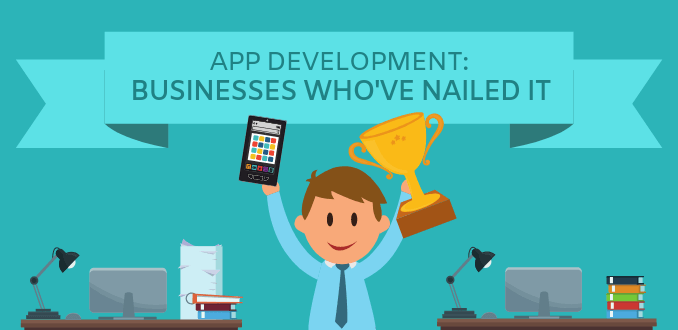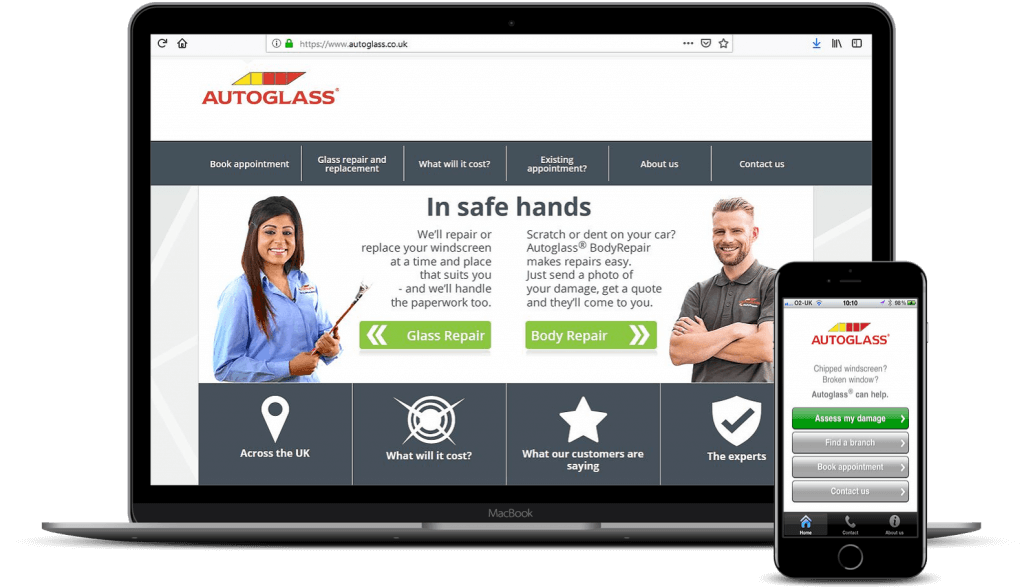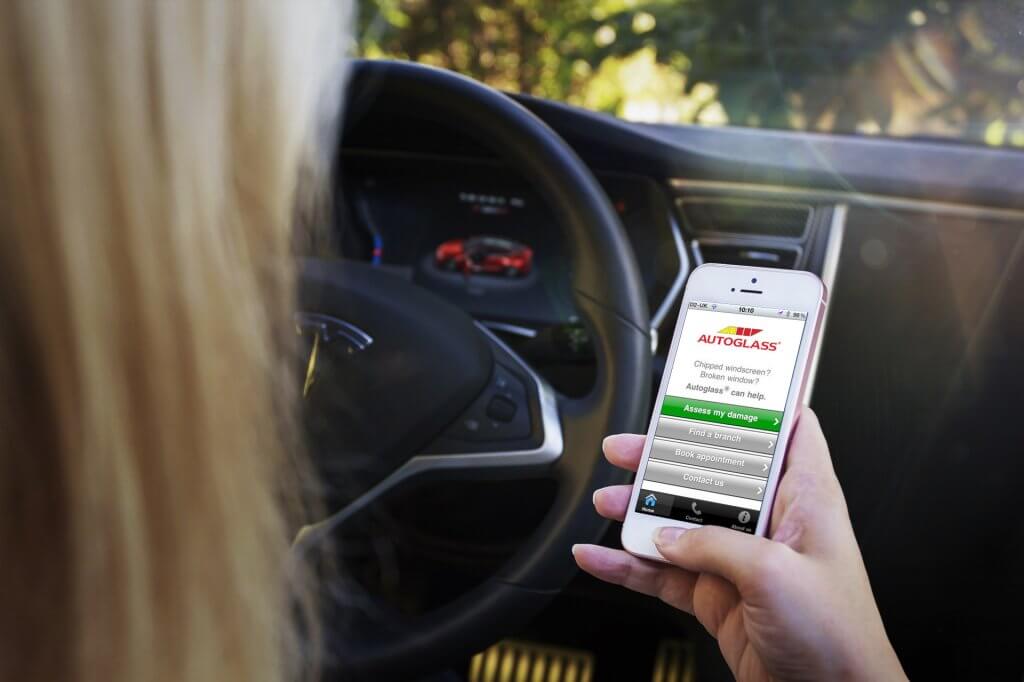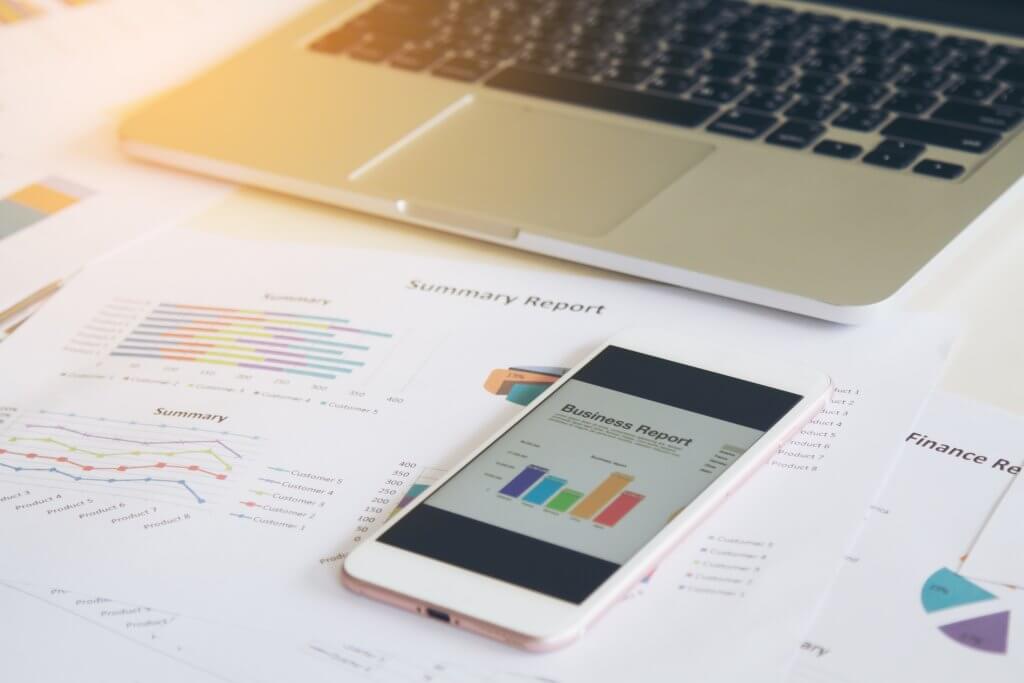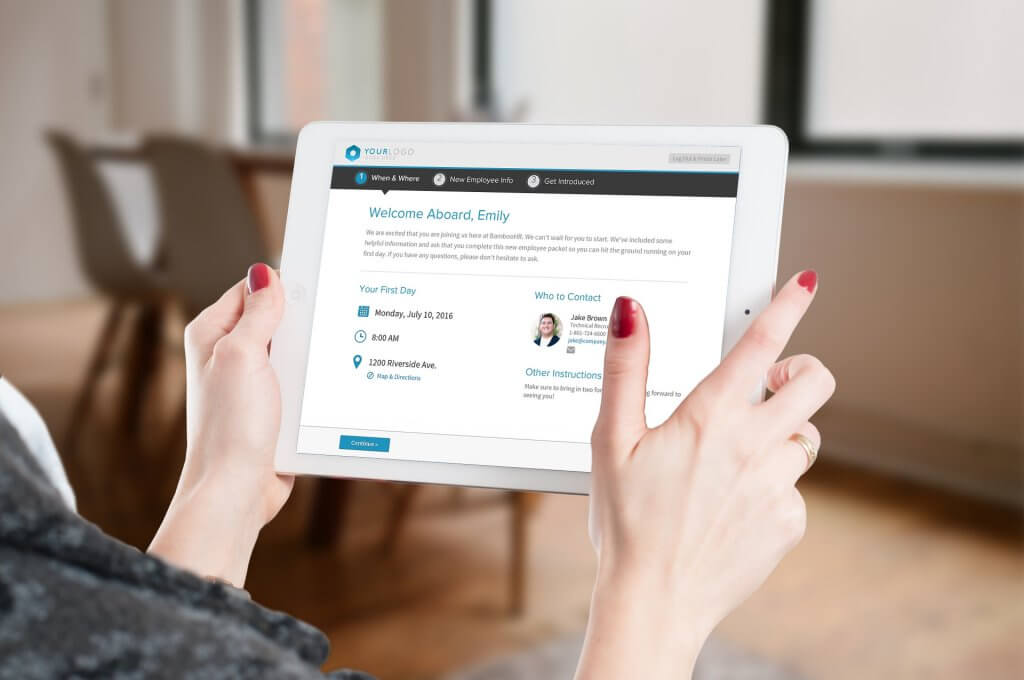Business App Development – Examples of Businesses Who’ve Nailed It
Many businesses are using mobile apps to do 3 important things:
- Overtake their competition
- Increase revenues
- Reduce their costs
You’re probably wondering:
“How do they do this?”
In this post, we cover 4 types of business apps with Case Studies. You’ll be able to see:
1. Which types might fit your business
2. Get some inspiration from businesses already using mobile to their advantage
Type 1: Customer Focused Apps
Apps are a great way to deliver a better, faster, much simpler experience for your customers.
They give you customers freedom to:
1. Do things instantly
2. Do things when they want to
3. Do things much quicker
Apps reduce friction for customers. They make it easier for your customers to do business with you. This naturally gives you advantage over your competition. Your customers may have a slower, manual process. A process that can only be followed during business hours, for example. This makes it harder for you to do business with.
When people are using your app and it’s quicker and easier than your competitors, they’ll keep coming back. That represents a powerful advantage over your competitors.
Case Study: Autoglass
A great example of this is the Autoglass app.
Autoglass are a vehicle glass repair and replacement company. They’ve developed an iPhone and Android app that allows users to send photos of their damaged car window or windscreen.
Once they send a photo of the damaged windscreen via the app, the app automatically assesses, using artificial intelligence, whether the damage can be repaired or whether the windscreen needs totally replacing.
Before the app, determining if the windscreen needed replacing or repairing required manual, in-person assessment. The customer would have to book an appointment with Autoglass, the guy would come out, he’d take a look and then assess whether it needed repairing or replacing.
A lot of times, if it needed replacing they wouldn’t have the right materials to be able to replace it there and then. The customer would have to book another appointment, and have to wait days, maybe weeks, for the Autoglass repairer to come back again to fix it. All this time, they may not even be able to use their car!
The app has delivered a huge benefit to Autoglass and its customers. Autoglass save time and money as repairers don’t need to go out and assess – there are no wasted trips. Assessment is done via the app, so when the repairer turns up, they have the right parts in order to fix the problem.
Customers know they just need one appointment to resolve the problem. This makes it a lot quicker, easier and better for their customers.
The great thing is, that’s just one of the features of their app.
The other features they have are:
- Request and book an appointment using the app;
- Request a callback
- Find the nearest Autoglass branch.
By developing an app, they’ve delivered a far superior customer experience.
Damage to your car can occur randomly, and with the app you can book an appointment in just a few minutes and know that it will be resolved. It’s really simple, fast and easy to use and their competitors don’t have anything similar. It’s a huge advantage to Autoglass, allowing them to gain more customers, more market share and more profits.
Is there a way that you can make it easier for your customers? Can you make it simpler for them to do business with you by using an app?
Type 2: Field Service Apps
Field Service apps used by workers who carry out tasks away from the office, typically at client locations.
An example would be technicians or engineers visiting customer sites to resolve faults or conduct maintenance.
These types of employees could use an app to do the following tasks:
- Have a calendar of upcoming jobs/visits – so they can easily keep track of upcoming jobs
- Access the customer site address and get directions to how to drive there
- Easily see the customer’s contact details to rearrange
- Have an inspection or maintenance form on the app, so they can easily record work carried out on the visit.
- The app can be used take photos of any problems or faults encountered,
- Write notes on any problems
- Upload completed inspection reports to head office database or email to client right away
Once the inspection is finished, an invoice can be generated onsite and set to the customer, there and then. This saves time.
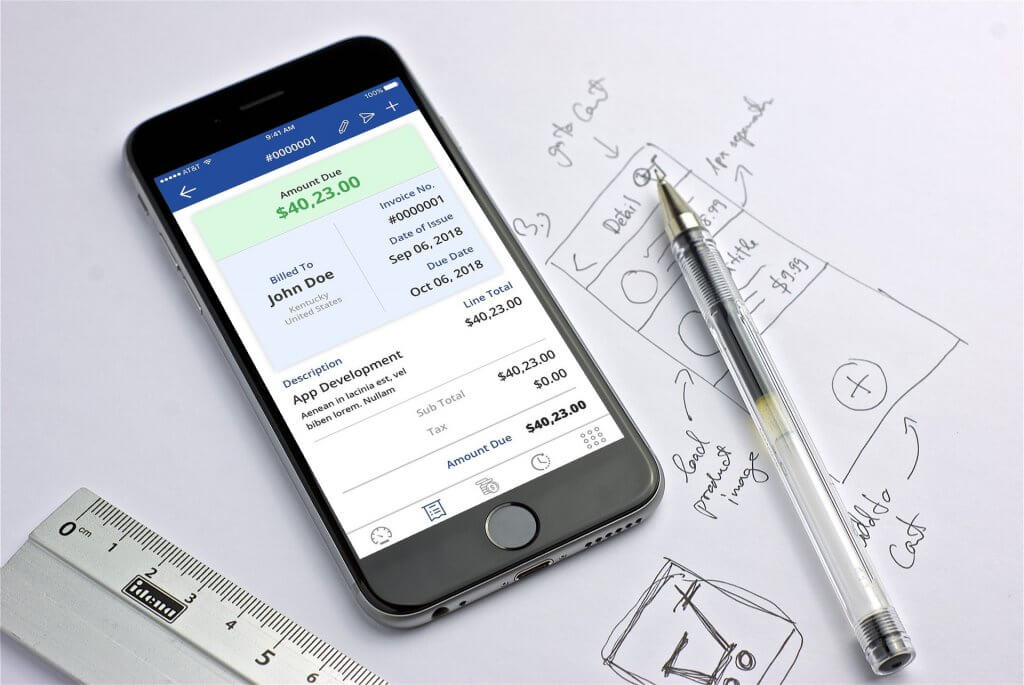
All of this information – the invoice, the work that they’ve carried out on the site, upcoming jobs, past jobs – can easily be uploaded to a central company system that keeps track of everything. That system can be used to manage future jobs, to send engineers jobs on a daily or a weekly basis.
Case Study: Mast Lighting Company
An example of an actual field service app is for a company that supplies mast lighting. (Mast lighting is the big outdoor lights you might see on a motorway or at an airport).
The company install and maintain this lighting. They need to conduct regular inspections on the lighting to make sure everything’s working okay.
Whenever they conduct an inspection, they produce inspection reports which need to be signed off by the customer.
The process they were using was all paper-based. Technicians would go onsite and record everything on a paper form! As you can imagine, this is very slow and awkward. It’s also very admin-intensive, inefficient and prone to errors.
The existing system meant that:
- Inspections took longer. Everything needed to be recorded on paper – meaning less sites were inspected each day
- Admin staff at head office were required to enter the data captured on paper into the company system
- Problems would arise if the paper forms were lost or damaged (by rain, for example)
An app and supporting system for the company would completely overcome these problems.
By taking the paper form and putting that on an Android tablet app, it would be a lot easier and quicker for data to be captured. The app can pre-populate certain fields, such as site address, or type of lighting. The app can use drop-downs and buttons to capture data much quicker.
Photos or videos of defects can be taken and added to the form. A list of faulty parts can be noted, which can then be ordered immediately.
Completed reports are converted to PDF and clients can add their signature to them on site, to confirm the inspection has been completed. Reports can then be emailed to clients right away, and invoices issued.
Also, all completed inspection reports are stored on the company database. The data here can be analysed, allowing the company to see where the majority of defects or problems are. This information is then fed back into their manufacturing process, and changes made, so that future lights they produce don’t have these defects.
There have been many benefits:
- Reports are completed around 30% faster using the app
- Admin staff have been freed up to concentrate on other tasks as they no longer need to file reports away, entering data into the system, etc.
- Invoices are issued quicker, resulting in faster payment from customers
Does your business involve any field workers, or conducting of inspections?
Type 3: Process Simplifying Apps
Process simplifying apps are used by companies to speed up or improve an existing inefficient process. Apps can receive information from a number of sources, allow data to be captured and updated in real time, and can be used to store information, such as documents, photos and videos. This mean information can be stored, processed and shared far more quickly than before.
Case Study: Fire Alarm Manufacturer
A client was a fire alarm manufacturer. Their alarms were installed by third-party engineers who had attended a training course provided by the manufacturer.
The manufacturer was facing a problem: the 3rd party installers, when they would get onsite installing these alarms, would have problems. They would then call the manufacturer’s telephone helpdesk and would try and resolve the problem over the phone with the helpdesk staff.
The manufacturer felt this was extremely inefficient. Many of the issues helpdesk staff were dealing with were minor and could easily be rectified, if installers had a troubleshooting guide or the right information with them.
Also, as this was being done over the phone, a lot of time was wasted because the helpdesk staff couldn’t actually “see” the problem. Time was wasted explaining the problem and trying to understand what it was, so problems often took longer to resolve.
The solution we proposed for this was extremely simple. It was to develop an app for the installers.
On the app there are video guides and PDFs which contain information on how to fix common issues, an FAQ section, and a troubleshooting guide. If this didn’t resolve the problem, installers could take photos and videos via the app, and submit them to the helpdesk; which meant it was quicker and easier to diagnose and fix problems.
One additional, hidden benefit of the app is by incorporating analytics and tracking into the app, we are able to see what the most common issues the installers had.
With this information, the manufacturer can spend extra time on their onsite training on these specific areas. This then reduces problems when the installers are onsite.
The benefits to the manufacturer have been:
- Huge reduction in time spent by helpdesk staff on the phone dealing with problems. It’s freed them to focus on more productive tasks such as sales.
- Reduced the number of helpdesk staff needed, with result in cost savings
- Installers more satisfied, meaning likelihood of recommending the manufacturer’s systems to clients has increased – resulting in more sales for the manufacturer
Do you have any slow, inefficient processes? Do you have any processes your customers, staff or suppliers often complain about?
Type 4: Internal Employee Apps
There are many ways apps can be used in a company for the benefit of your own employees.
For example, employee induction. When you join a company, there can be an app that provides a new joiner with all the information they need to get them up to speed and settle in as quickly as possible. The app can be easily updated by HR so that the information stays current.
It’s a great way to ensure that your new joiners hit the ground running.
Expenses are another example. Submitting expense claims is often a cumbersome and time-consuming experience. Apps can allow staff to take photos of their receipts and claims and submit them from where they are.
Booking of holidays can be done via an app. Similarly travel booking and meeting room booking.
Employee apps can help get these admin tasks done quicker and more efficiently, which ultimately saves your organisation time and money.
Case Study: Improvement Suggestions App
A construction company was very focused on customer service and providing the best experience for their clients. They have many direct employees, contractors, and partners. They wanted to understand how they could improve, but with a diverse and geographically dispersed workforce, it was hard for them to capture ideas from their staff.
These ideas could be about delivering a benefit to their customers, or could include ideas to improve health and safety at project sites, but also include identifying new business opportunities.
The solution was to create a ticketing app that would allow staff, suppliers or contractors to provide feedback via an app in a streamlined way.
The app can:
- Allow users to add a photo or a video to the ticket as evidence
- The app works offline – this meant users out in the field without internet connectivity can still record all the details at the right place and right time. If they aren’t connected, the ticket will be safely stored and submitted when internet connection is re-established.
- Users can browse, filter and sort submitted tickets so they can keep track of their submissions. The app also introduced feedback notifications, so the user knows the status of their ticket. This visibility encourages users to submit opportunities as they now have visibility over the whole process.
The app provides a huge benefit to the company, allowing them to capture ideas that help them to constantly improve, spot new opportunities and stay ahead of the competition.
Do you have any employee admin tasks that can be done via an app?
Conclusion
Are there any opportunities for your organisation to incorporate apps to improve your performance?
Think about the following questions to help get you started:
- Do we have any slow, or inefficient processes?
- How can we make it easier for our customers to do business with us?
- What are the most common complaints we receive, from either our customers or employees?
- Do we have any paper-based processes that could be automated?
Free In-Depth Consultation
Do you have an app idea that you’re thinking of developing?
We’ve set aside some time to personally review your idea, and provide our expert feedback on it…FREE.
With over 20 year’s combined app experience in our company, we will thoroughly review your idea and:
- Make suggestions on how it can be improved
- Suggest features you may not have thought of
- Let you know a score of between 1-10 on how technically complex it is (1 being easy, 10 being extremely complex)
- Inform you of any technical gremlins you need to be aware of (that might cause problems later)
- Provide an estimate on how much it might cost to develop (and how long it will take)
This is a free, in-depth consultation, lasting up to 60 minutes.
If this sounds interesting to you…just click this link here, or click the orange “Book Now” button below. Then fill in your details, and one of the team will get in touch with you to arrange your Free Consultation.
